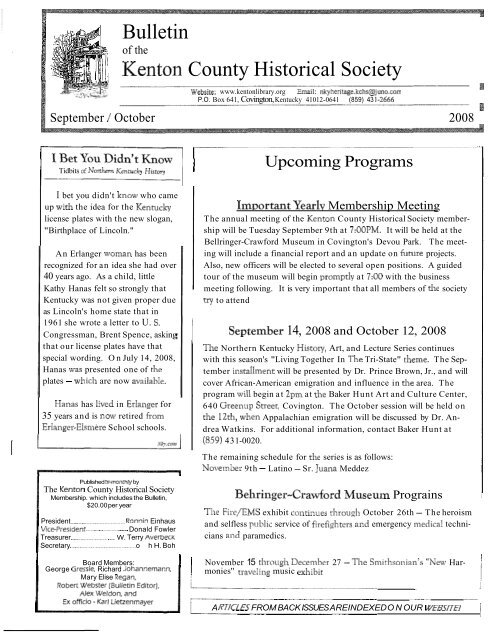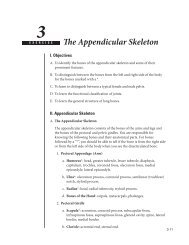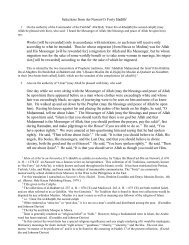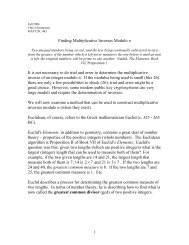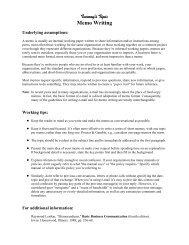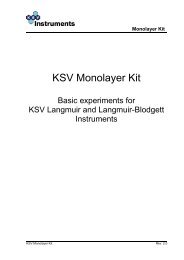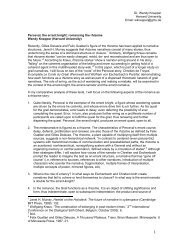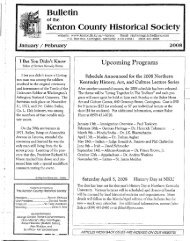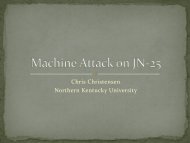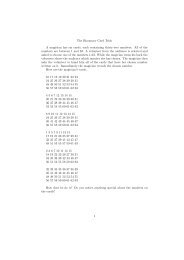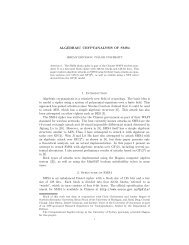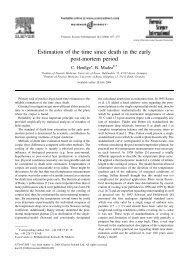1 - Northern Kentucky University
1 - Northern Kentucky University
1 - Northern Kentucky University
Create successful ePaper yourself
Turn your PDF publications into a flip-book with our unique Google optimized e-Paper software.
Bulletin<br />
of the<br />
Kenton County Historical Society<br />
Website: www.kentonlibrary.org Email: ~lkyheritage.kchs@juno.com<br />
P.O. Box 641, Covington, <strong>Kentucky</strong> 41012-0641 (859) 43 1.2666<br />
September 1 October 2008<br />
Tidbits of Nalrl~m Kentuck? Hktq<br />
I bet you didn't know who came<br />
up with the idea for the Kentuclcy<br />
license plates with the new slogan,<br />
"Birthplace of Lincoln."<br />
An Erlanger woman has been<br />
recognized for an idea she had over<br />
40 years ago. As a child, little<br />
Kathy Hanas felt so strongly that<br />
<strong>Kentucky</strong> was not given proper due<br />
as Lincoln's home state that in<br />
1961 she wrote a letter to U. S.<br />
Congressman, Brent Spence, asking<br />
that our license plates have that<br />
special wording. On July 14, 2008,<br />
Hanas was presented one of the<br />
plates - which are now available.<br />
Hallas has livcd in Erlanger for<br />
35 years and is now retired from<br />
Erlanger-Elsmere School schools.<br />
Published hi-rnanrhly by<br />
The Kenton County Historical Society<br />
Membership. which includes the Bulletin,<br />
$20.00 per year<br />
President ................................ R o n Einhaus<br />
Vicepresident .......................... Donald Fowler<br />
Treasurer ....................... W. Terry Averbeck<br />
Secretary .................................... o h H. Boh<br />
1<br />
I<br />
Upcoming Programs<br />
Iinuortant Yearlv Membership Meeting<br />
The annual meeting of the Kenton County Historical Society member-<br />
ship will be Tuesday September 9th at 7:OOPM. It will be held at the<br />
Bellringer-Crawford Museum in Covington's Devou Park. The meet-<br />
ing will include a financial report and an update on future projects.<br />
Also, new officers will be elected to several open positions. A guided<br />
tour of the museum will begin promptly at 7:00 with the business<br />
meeting following. It is very important that all members of the society<br />
try to attend<br />
September 14, 2008 and October 12, 2008<br />
The <strong>Northern</strong> <strong>Kentucky</strong> Histoq~, Art, and Lecture Series continues<br />
with this season's "Living Together In The Tri-State" theme. The September<br />
iilstallment will be presented by Dr. Prince Brown, Jr., and will<br />
cover African-American emigration and influence in the area. The<br />
program will begin at 2pm at the Baker Hunt Art and Culture Center,<br />
640 Greenup Saeet, Covington. The October session will be held on<br />
the 12th, when Appalachian emigration will be discussed by Dr. Andrea<br />
Watkins. For additional information, contact Baker Hunt at<br />
(859) 43 1-0020.<br />
The remaining schedule for the series is as follows:<br />
November 9th - Latino - Sr. Juana Meddez<br />
Behringer-Crawford Museuin Prograins<br />
The Fire/EMS exhibit contii~ues through October 26th -The heroism<br />
and selfless puliiic service of fi~.efighters and emergency meciical technicians<br />
and paramedics.<br />
I Board Members: I November 15 tl~rough December 27 -The Smirhsonian's "New Har- i<br />
I George Gressle. Richard Johannemann. monies'' traveli~lg music exhihit<br />
Mary Elise Regan,<br />
.. 1<br />
---<br />
A R77CLES FROM BACK ISSUES AREINDEXED ON OUR WEBSITEI 1
By the late 1850s, the city limits of Coving-<br />
ton, <strong>Kentucky</strong> extended from the Licking River on<br />
the east to just past Willow Creek (now 1-71/75) on<br />
the west and from the Ohio River on the north to<br />
about Nineteenth Street to the south. Not get an-<br />
nexed by the city was Wallace Woods and Buena<br />
Vista, (areas now comprised by East 20" Street, East-<br />
ern Avenue, Madison Avenue, and 26'" Street) and<br />
Central Covington, (area now comprised by Madison<br />
Avenue, 26th Street, Highland Avenue, and rhe Ft.<br />
Wright city limits to the west).'<br />
At the time, Covington already had four Ger-<br />
man parishes serving its Catholic citizens - Mother of<br />
God, established in 1841, St. Joseph Church, estab-<br />
lished in 1853, St. John Church, established in 1854,<br />
and St. Aloysius Church, established in 1861.2<br />
By the late 1860s, the need for a fifth church<br />
was seen for the predominantly German residents of<br />
Central Covington, also known as Peaselburg The<br />
new church's boundaries would actually extend<br />
nearly six miles to the south.' St. Augustine Parish<br />
was established on June 20, 1870. Its name was che<br />
sen in honor of the patron saint of the new Bishop of<br />
Covington, Most Reverend Aug~~stus Maria Toebbe,<br />
D.D. The cornerstone for the combination church<br />
and school was laid, and the building was dedicated<br />
on October 16, 1870. Father L. Neumeier was its<br />
first pastor.<br />
There seems to be some discrepancy, however,<br />
as to the exact location of the first St. Augustine<br />
Church. Most histories of the parish place<br />
the building on Augustine Street - which certainly<br />
makes sense -but is incorrect. The 1877 Atlas, an<br />
St. Augustine Church<br />
Coverphoto. sketch of the present chzlrch by Jzrstin Kendig<br />
(coirrtesy KCPL Amhrves)<br />
Above: Covington j. St. Ac~gustine Church rodny<br />
(cosvle~y Bob Websler)<br />
Between 1905 and 1910, several streets in the<br />
neighborhood were renamed. What was Holman be.<br />
came Russell, what was Howard became West 20th<br />
Street and what was Russell became Au~istine Street.<br />
The naming of Augustine Street was certainly in<br />
honor of the church and school, but important to remember<br />
is that the church and school was never located<br />
on Aumstine Street.<br />
early iphotograph of the neighborhood taken from<br />
atop the nearby Monte Casino property, and all City Peaselburg, at the time, was nothing more<br />
Directories spanning thirty years clearly indicate this than a small village with scattered homes, hut the in- !<br />
is not the case. The structure was actl~ally located on flux of Catholics in the area was rapid during the<br />
Holn~an Street at its intersection with Howard Street. .next few years. In February 1871, Reverend Joseph<br />
I
John %If<br />
Homd Street was renamed West 20th 1 Wliat is shorn as I{ohnan Street is now Russell<br />
Goebbels succeeded Father Neulneier. Father Goebbels<br />
undertook several projects to enhance the parish<br />
property and to increase church revenue. During a<br />
European trip in 1875, he purchased a wire nail<br />
manufacturing machine and brought it back to<br />
Peaselburg? He and parishioner, Barney Melbers,<br />
started the American Wire and Screw Nail Company<br />
in December 1875, "...for the manufacture of all<br />
kinds of wire good^."^ The nlachine was initially set<br />
up in the back rooin of Melbers' saloon, at the corner<br />
of Madison Avenue and Wlllow Street (now West<br />
ITd'). Witl~in two years, a total of ten machines were<br />
manufacturing goods that were being shipped as far<br />
away as San Francisco, Califor~nia.~ Profits from the<br />
company were intended to fund the constr~iction of a<br />
new church and school, but almost immediately, due<br />
mostly to a strong downtllrn in the national economy,<br />
the company failed. The parish could no longer<br />
meet its obligations and its creditors eventually filed<br />
suit in 1881.' Coilnpany property and other church<br />
holdings were sold. Luckily, parishioners were able<br />
to pool personal funds and purchase the combination<br />
churcln and school, as well as its furnishings.<br />
Father Goebbels left the parish and was re-<br />
placed by Father William Robbers in 1877. Four<br />
years later, Father Robbers and the Board of Trustees<br />
organized a corporation known as the Roman Catho-<br />
lic German Church of Central Covington, Kent~cky.~<br />
During Father Robbers' years, a request was made<br />
and gralnted for a new parish, to be located in the vi-<br />
cinity of Decoursey, u.hich became St. Anthony<br />
Ch~~rcln.~<br />
In 1879, Father Clement Jesse became the<br />
third pastor of St. Augustine Church. His ill health,<br />
however, prevented much parish activities. He died<br />
in June of 1883 and Father Paul Abeln became the<br />
church's fourth pastor. Father Abeln brought order<br />
out of chaos, resurrecting the parish from what had<br />
been a victim of n~ismanageineint and the subject of<br />
much embasrassment. His immediate success<br />
brought the parish out of debt, and he was able to<br />
raise more than $34,000 toward the dream of a new
Photograph of the originalst. Augustine Church andSchoo1, circa 1890. The structure was located at what is today<br />
the eastern side ofRussell Street, opposite FYesf 20th Street. Photo eozrrlesy KCPL Archives<br />
and bigger church for the congregation. Also during<br />
Father Abeln's years, other divisions were required for<br />
the growing number of German Catholics in Coving-<br />
ton and surrounding areas. In 1885, St. Benedict<br />
Church was erected on East 16'" Street and in 1890,<br />
the town of Milldale [now Latonia] became home to<br />
Holy Cross-Church.'"<br />
Father Abeln's dream of seeing a new St.<br />
Aup~stine Church was never realized, however, as he<br />
died on April 10, 1911." On May 11, 1911, Reverend<br />
William F. Kathman lxcame the church's fifth<br />
pastor. Father Kathman continued to lead the parish<br />
with plans to build a new Church. On May 7, 1912,<br />
the parish purchased land on the north side of West<br />
19'" Street, between Euclid and Jefferson Aveni~es.'~<br />
Work on the new Church was begun May 8,<br />
1913, and the cornerstone was laid on Sunday, Sep-<br />
tember 21, 1913. The new Italian Renaissance Style<br />
church was designed by Newport architect David<br />
Davis and was constructed of chocolate color rough<br />
brick." A large brick residence on the corner of 19'"<br />
and Euclid was moved to the northeast edge of the<br />
property to become the Sisters' residence. The parcel<br />
included another home, located on the northwest corner<br />
of the property, which became the pastor's residence.<br />
Bishop Maes dedicated the new St. Augustine<br />
Church on December 20. 1914. Much of the interior<br />
was decorated by the private donations of parishion-<br />
ers. These gifts included: High Alter by Mrs. Louis<br />
Trenkamp, Conlmunion Rail by Frank Rroeritig, and<br />
the Stations of the Cross by Mrs. C. Pohlman. The<br />
entire cost of the new church was $106, 074.53.14<br />
The original Church was auctioned to a single bidder.<br />
i
Several men of the parish pledged to save the church<br />
bell, and they were successful. Church membership<br />
at this time was 210 fa mi lie^.'^<br />
After completion of the new church, Father<br />
Kathman turned his attention to the construction of<br />
the much-needed new school. Work began in the<br />
fall of 1915 and by January 1916, the cornerstone<br />
had been laid. The school was dedicated on Septem-<br />
ber 10, 1916 and cost $39,498.30 to build. By<br />
1920, enrollment stood at 300.16<br />
St. Augustine Parish celebrated its Golden<br />
Jubilee on June 20, 1920, and the small congrega-<br />
tion of 1870 had grown to 325 families, one of the<br />
best-organized congregations in the city of Coving-<br />
ton, under the guidance of Father Kathman." By<br />
the mid 1920s, new subdivisions were being built in<br />
the area, bringing even more families to the church.<br />
Father Kathman died on March 14, 1926<br />
and was succeededby Reverend Charles A. Woeste.<br />
Father Woeste enjoys the distinction of being pastor<br />
of St. Augustine for 3 1 years. An able administrator,<br />
he renovated the entire interior of the Church,<br />
remedying the acoustical difficulties, redecorated the<br />
walls and renewed the Stations of the Cross. By the<br />
late 1940s, the school was filled to capacity. An expansion,<br />
housing two classrooms, a gymnasium,<br />
locker rooms and additional restrooms was completed<br />
in 1953. By the late 1950s, church membership<br />
included over 500 families, with more than<br />
2,000 total member^.'^ Monsignor Woeste died on<br />
Decelnber 10, 1957, after nearly 32 years of loyal,<br />
atte~~tive, and devoted service to St. Augustine Par.<br />
isll. Reverend Joseph A. Lubrecht hecame his successor<br />
and remained at St. Augustine until 1977.<br />
In the early 1960s, Vatican I1 Council called<br />
forth a renewal in the Church. St. Augustine Parish<br />
eml~raced that call and renovated the Church and<br />
prepared the parishioners for the changes in the<br />
Mass and in parisl~ life. This was accomplished ullder<br />
the direction of Monsignor Lubrecht. The pastorate<br />
exercised by Father Lubrecht reflected the<br />
work of Father Abeln, Father Kathman, and Father<br />
Woeste. His loyalty and acceptance of autllentic<br />
Groundhreaking ceren7onies for St. Augustine Church<br />
oilore rile fairly-i~e>ii Fiflil Disirici Scl~ool in the backgiouiid)<br />
teaching of the Church gave him an equally honored<br />
niche in the great tradition of his predecessor^.'^<br />
On June 7, 1970, St. Augustine Parish celebrated<br />
100 years as a parish. Most Reverend Richard<br />
H. Ackerman, D.D. concelebrated a Pontifical Mass followed<br />
by a Centennial Banquet. The "fresh air" of Vatican<br />
I1 continued to blow through the leaderships of Father<br />
Joseph Broering, pastor from 1977 t~ 1987, and<br />
Father Donald Hellman, pastor from 1987 to 1992.20<br />
In 1991, Father Hellman and the parish established the<br />
St. Augustine Center at Ida Spence Homes (now City<br />
Heigl~~). The center was initially staffed by parish volunteer<br />
Bernie Ashworth. The center provided food<br />
and clothing assistance, as well as tutoring and religious<br />
education to the residents."<br />
Father Leo Schmidt became pastor of St.<br />
Augustine in 1992 and remains there today. Due to<br />
urban flight, with many families nloving to the suburbs<br />
and abancioning the inner city, enrollnlent at Lot11 St.<br />
Augustine Church and the School has Lxen on a steady<br />
decline for the more than twenty years. In 1995, the<br />
Church celebrated its sesquicentennial with appropriate<br />
ceremonies. TodaTr, a highly dedicated faculty,<br />
many of whom have Lbeeli in the urban classl-oom<br />
throughout their careers, teach over I20 students at the<br />
school. Today, church menlbership includes more<br />
than 300 families aild uncie~- the leadership of Father<br />
Schmidt, the Parish continues to respond to the needs<br />
of the people of the area.<br />
E17dno/es lo /his article can he fouild or? page 10
This article attempts to giue a brief ouerwiew of certain<br />
coaches/ndministrators in <strong>Northern</strong> Kentzrcky sports his-<br />
toTy.<br />
In 2004, the <strong>Northern</strong> <strong>Kentucky</strong> Sports Hall<br />
of Fame and the Behringer Crawford Museum hosted<br />
"Batters Up!" In 2006 they presented the "Coach's<br />
Comer" honoring high school coaches from 1950 to<br />
the present. Ken Shields, a coach for forty years,<br />
mentored some thirteen current coaches. The exhibit<br />
noted pioneers who had helped open the profession<br />
to women, including Donna Wolfe and Joan Mitchell<br />
(Holmes), Margie McKenna (Campbell County), and<br />
Naomi Delaney Melia (Dayton).'<br />
In 2008 the Hall of Fame and Museum pre-<br />
sented "Reach for the Stars," honoring ninevane<br />
athletes. Seven of them-Donna Wolfe, Stan Steidel,<br />
Me1 Webster, Bill Schwarberg, Homer Rice, Janie<br />
Scheper Meier and Roger Klein, exemplify those who<br />
followed up with successful careers in coaching and<br />
administ~ation.~<br />
Donna Wolfe<br />
A graduate from ~olmes High School in<br />
1965, Donna Wolfe played high school basketball,<br />
volleyball and softball. A great slow pitch amateur<br />
softball player for twenty years, her team appeared in<br />
thirteen narional championship tournaments, winning<br />
six titles: Wolfe graduated from Eastern <strong>Kentucky</strong><br />
<strong>University</strong> with a B.A. in 1969 and an M.A. in<br />
1970, and received an award as outstanding woman<br />
athlete. A softball coach for twenty years and a volleyball<br />
atnd basketball coach for twelve, she took<br />
Holmes to <strong>Northern</strong> <strong>Kentucky</strong> Athletic Conference<br />
titles in three sports. She is a member of the Greater<br />
Cincinnati Softball All-Centu~y Team. In 1979 she<br />
was inducted into the Amateur Softball Association<br />
Hall of Fame and in 2007 into the Dawahares <strong>Kentucky</strong><br />
High School Arhletic Association Hall of Fame<br />
"Reach For The Stars"<br />
Seven Coaches/Administrators<br />
John Boh<br />
When an effort to get women's high school<br />
volleyball and softball sanctioned was denied in 1979,<br />
Donna Wolfe and others looked to Federal Title IX<br />
legislation and filed suit. Four athletes including<br />
Wolfe pushed to get the <strong>Kentucky</strong> High School<br />
Sports Association to establish the <strong>Northern</strong> Ken-<br />
tucky Conference for girls. Her leadership also is<br />
documented in a photograph of her and other adve<br />
cates watching Governor Martha Layne Collins offi-<br />
cially sign legislation promoting equal funding for fe-<br />
male sports in <strong>Kentucky</strong>. She was a member of the<br />
Citizens Sports Equity Executive Board for fifteen<br />
years.3<br />
Stan S teidel<br />
A graduate of Dayton High School in 1959,<br />
Stan Steidel played collegiate basketball. Starting in<br />
1966 and for over 30 years he coached sports includ-<br />
ing baseball, football and basketball at Dayton High<br />
School and was the last to handle both football and<br />
basketball at the same time in <strong>Northern</strong> <strong>Kentucky</strong>.<br />
He won the Greater Cincinnati Basketball High<br />
School Hall of Fame Lifetime Achievement Award.<br />
For high school administration, athletic director Stei-<br />
del was honored in 1991 with the National Intersche<br />
lastic Athletic Administrators Association's Award of<br />
Merit, the only person ever from Northem <strong>Kentucky</strong>.<br />
He led in the establishment of the "All-A Classic" for<br />
boys and girls basketball players, a statewide tourna-<br />
ment for smaller schools. Steidel is a member of the<br />
Dawahares <strong>Kentucky</strong> High School Athletic Associa-<br />
tion Hall of Fame. Recently an overseer of Title I for<br />
the Covington School system, he was also Executive<br />
Director of the <strong>Northern</strong> <strong>Kentucky</strong> Athletic Confer-<br />
ence<br />
Me1 Webster<br />
A graduate of Holmes High School in 1971,<br />
Me1 Webster was editor-in-chief of the Northe~.n Ken,<br />
tz~cky Sporn magazine from 1976 to 1992. At Bishop
Brossart, Webster has coached eighteen softball Homer Rice<br />
championship teams and also has been Athletic Di-<br />
rector. Typically, in 1993 his softball team won 35<br />
and lost 6.* Webster in 1990 won the <strong>Kentucky</strong> Girls<br />
Sports Association Citizens Award. In 1996 Webster<br />
was honored with the <strong>Kentucky</strong> Citizens for Sports<br />
Equity Award. Webster in 2000 was inducted into<br />
the <strong>Northern</strong> <strong>Kentucky</strong> High School Athletic Direc-<br />
tors Hall of Fame. A high school umpire for twenty-<br />
two years, Webster has worked over 3,000 games, in-<br />
cluding twenty for regional championship, and seven<br />
KHSAA State Tournaments. A high school public<br />
2, address announcer for over thirty years, Webster has<br />
=l covered over 3,600 games and Girls Ninth Region<br />
championships twenty-five years in a row.5<br />
1<br />
Bill Schwarberg<br />
Bill Schwarberg enjoyed a veq~ unique and fulfilling<br />
career in athletics. He played on the undefeated<br />
Holmes High School football team of 1931.<br />
He earned a B.A. at the <strong>University</strong> of Cincinllati<br />
while playing quarterback in football and shortstop in<br />
baseball. After a season at quarterback for an earlier<br />
Cincinnati Bengals franchise, he became the first<br />
football coach at Dixie Heights High School. In 1940<br />
he coached an undefeated John G. Carlisle basketball<br />
team. Having earned a Masters Degree, in 1942 he<br />
became athletic director and football, basketball and<br />
assistant ~hysical education coach at Holmes High<br />
School. He coached the Holmes football teain to an<br />
undefeated season including the championship in the<br />
state tournament.<br />
In 1944 his Holmes basketball team played in<br />
the state tournament. In 1946, after being discharged<br />
from the US Navy. Schwarberg became a university<br />
coach, then a universiq) administrator. He was an assistant<br />
football coach at UC during a decade of winning<br />
seasons including four conference titles and<br />
three bowl game appearances. He also coached UC<br />
golf from 1954 to 1982 and helped out as a baseball<br />
coach. Studying during summer months, Schu~arberg<br />
earned a PhD from Columbia <strong>University</strong>. I11 1963 he<br />
became assistant athletic director at UC and in 1976<br />
sewed as interim AD. Scl~warber~ once stated that "a<br />
u<br />
good teacher" is "someone who would do for notl~ing<br />
what he is being paid to do."6<br />
A graduate of Highlands in 1945, Homer<br />
Rice was a high school star as a football quarterback<br />
and also in basketball and track. He later played<br />
three years of professional baseball in the Brooklyn<br />
Dodgers organization. An innovative football coach,<br />
Rice's Highlands team won fifty games in a row and<br />
won two AA state championships. He embedded a<br />
winning nadition at Ft. Thomas Highlands with a re-<br />
cord of 102 victories, nine losses and seven ties.<br />
Later, he was head coach at the <strong>University</strong> of Cincin-<br />
nati as well as the Cincinnati Bengals.<br />
--<br />
When director of athletics at the <strong>University</strong> of<br />
North Carolina, he saw published, Home7 Rice on T7i-<br />
ple Option Football (1973). He also wrote Lessons for<br />
Leaden, Building a Wxnning Team fiom the G~ound Up<br />
(2000) and Leadenhip Fitness, Developing and Reinfo~c-<br />
ing success fir^ Positive Leaden (2004). As an athletic<br />
director at the Georgia Institute of Technology he<br />
was recognized for outstanding achievement with an<br />
award from the National Association of Collegiate<br />
Directors of Athletics.<br />
Jane Scheper Meier<br />
A graduate of Villa Madonna Academy in<br />
1969, and Mt. St. Joseph College in 1973, Jane<br />
Scheper Meier played high school and college basketball<br />
and volleyball. She was recognized as outstanding<br />
athlete at both levels. After college she<br />
coached at Notre Dame Academv in Park Hills. Ac+<br />
cording to the student year book, "this year the varsity<br />
volleyball team surpassed all of its goals ... with the<br />
great coaching of Jane Scheper, they accomplisl~ed a<br />
26 and 2 won-lost record ... first place for the season"<br />
and in the league tournament. Likewise "NDA's basketball<br />
team had a much ilnproved season with 10<br />
wins and 5 losses" compared to 4 wins and 5 loses the<br />
previous year.'<br />
After time in graduate school, she coached<br />
the volleyball team at <strong>Northern</strong> Michigan Universiql<br />
in 1977. Then she coached voiley~ball and softball at<br />
Nortliern <strong>Kentucky</strong> Univei-sit)- from 1978 to 1988,<br />
taking both to post season tournaments and achieve<br />
ing national rankilngs. Her ~olle~~ball teams won 119,<br />
lost 55, and in 1985 won the Great Lakes Valley Con*
ference Championship, earning Meier Coach of the<br />
Year honors. Her softball teams won 99 and lost 59<br />
games. Like Schwarberg and Rice, Meier made her<br />
mark in university administration. The year before<br />
her graduation from Mt. St. Joseph College, Congress<br />
had approved Title IX, requiring equal opportunity in<br />
sports at institutions supported with federal funding.<br />
During her administration Janie Meier has overseen<br />
the growth of NKU athletics. In 1996 and 1997 the<br />
NKU men's basketball team was runner-up in the<br />
NCAA Division 11 tournament. In 1998 the women's<br />
volleyball team won the Division I1 Elite Eight and in<br />
1999 made the Division I1 Final Four. By 2000,<br />
Meier had served twelve years as Athletic Director at<br />
<strong>Northern</strong> <strong>Kentucky</strong> <strong>University</strong>.<br />
In 2000 NKU achieved its very first national<br />
championship in athletics under women's basketball<br />
coach Nancy Winstel, who was honored as the Na-<br />
tional Division I1 Coach of the Year. The NKU<br />
women's soccer, volleyball and tennis reams were hav-<br />
ing winning seasons. In 2000 NKU sponsored seven<br />
women's teams and six for men. For 2003-04 the Na-<br />
tional Association of Collegiate Directors of Athletics<br />
named Meier Athletic Director of the Year. In 2008<br />
the NKU women's basketball team won another na-<br />
tional champion~hip.~<br />
Roge Klein<br />
Coaches and administrators helped estaWsh<br />
other sports at the secondary and collegiate levels.<br />
Just when professional tennis was being introduced,<br />
Roger Klein excelled on Bellevue High School's first<br />
tennis team. After graduating in 1929, Klein played<br />
tennis at the <strong>University</strong> of Kenh~cky. In 1943 Klein<br />
returned to Bellevue commencing 32 years of coaching<br />
at his alma mater. In 1944 Klein helped to organize<br />
the <strong>Kentucky</strong> High School Tennis Tournament.<br />
His teams won 419 times and lost 98. In 1974 Klein<br />
retired from high school coaching at Bellev~~e. Then<br />
called to help develop the tennis program at <strong>Northern</strong><br />
<strong>Kentucky</strong> <strong>University</strong>, his men's team won two National<br />
Association of Intercollegiate Athletics District<br />
titles and in 1986 the Great Lakes Valley Conference<br />
Championship, the first title in that conference for<br />
any NKU men's team. The women's tennis reams<br />
won 72 and lost 63 under Klein. In 2001 he was inducted<br />
into the NKU Athletic Hall of Fame. and the<br />
BelIevue High School tennis facility is named to<br />
honor Klein.g<br />
Notes on <strong>Kentucky</strong> collegiate conferences<br />
In the early 1990s, <strong>Kentucky</strong> coIleges and uni-<br />
versities were sponsoring competition in four "major"<br />
conferences (Southeastern, Metro, Sunbelt and Ohio<br />
Valley) and three "minor" ones (Great Lakes Valley,<br />
College Athletic and <strong>Kentucky</strong> Intercollegiate). With<br />
headquarters in Birmingham, Alabama, the South-<br />
eastern Conference included Universitv of Kentuckv<br />
teams. The conference operated men's and women's<br />
basketball, crospcountry, indoor/outdoor track, golf,<br />
swimming and tennis; men's baseball and football;<br />
and women's gymnastics and volleybali. Formed in<br />
1975, the Metro Conference included the <strong>University</strong><br />
of Louisville. It oversaw men's and women's basket-<br />
ball, cross country, golf, swimming and diving, track<br />
and field and tennis; men's baseball; and women's<br />
volleyball.<br />
Formed in 1978, the Division I1 Great Lakes<br />
Conference started as a basketball league with charter<br />
members Bellarmine, and <strong>Kentucky</strong> Wesleyan.<br />
<strong>Northern</strong> <strong>Kentucky</strong> <strong>University</strong> joined in 1985, as did<br />
<strong>Kentucky</strong> State <strong>University</strong> in 1989. In 1983 it added<br />
Women's basketball, softball, tennis, volleyball and<br />
cross-counny and men's completion would include<br />
basketball, tennis, golf, soccer and cross-country." In<br />
2008, as a member of another-the NCAA Division<br />
111 Presidents' Athletic Conference-Thomas More<br />
College sponsors baseball and football for men; soft-<br />
ball and volleyball for women; and golf, soccer and<br />
tennis for both."<br />
Notes on some US sports<br />
In 1873 a British army officer introduced his<br />
invention of tennis at a garden club event, and in<br />
1874 tennis was played in America. Beginning in<br />
1877 amateur and club tournament play centered at<br />
Wimbledon. In 1881 the first American singles tour-<br />
nament was established and later moved to Forest<br />
Hills, NY. In 1900 organizers established interna-<br />
tional tournament competition, the Davis Cup,<br />
played first in Boston, providing men and women sin-<br />
gles and a doubles contest. A promoter iiltroduced<br />
American "professional" tennis in 1926.'2
As an article in the <strong>Kentucky</strong> Encyclopedia<br />
recalls, baseball was played even before the Civil War.<br />
By the late 1860s newspaper articles followed the early<br />
professional rivalry between Louisville and Cincinnati<br />
and by the 1870s and 1880s reported on baseball<br />
games in <strong>Northern</strong> Kenrucky.13 In the following cen-<br />
tury, besides high school, college and semi-pro, at least<br />
thirty-one <strong>Kentucky</strong> cities had professional, mostly<br />
Class D, minor league teams. Of the over 200 major<br />
league players from <strong>Kentucky</strong>, Jim Bunning has<br />
joined three others in the Baseball Hall of Fame-and<br />
two from Covington, Howie Camnitz and Bill<br />
Sweeney, once were candidates.<br />
The museum exhibit shoned a number of others<br />
from <strong>Northern</strong> <strong>Kentucky</strong> who played minor league<br />
and some who played on the Major League levelrecently<br />
Scott W~ggins, a 1994 graduate of Newport<br />
Central Catholic High School, with the Toronto Blue<br />
Jays in 2002.'4<br />
In ad tion to cu.rrent Walton resident<br />
Patricia Scott's stint in women's professioilal hardball<br />
("A League of Their Own"), women's softball in re-<br />
cent years has eained a lot of publicity at the high<br />
school and college levels. Nevertl~eless, Holmes<br />
graduate Donna Wolfe exemplified achievement in<br />
women's softball even before Title IX.<br />
At the veiy beginning of "American football"<br />
<strong>Kentucky</strong> <strong>University</strong> played Centre College in 1880.<br />
In 1893 two Louisville high schools started a longterm<br />
rivalr)~. By 19 14 larger high scl~ools more often<br />
were playing football. Formed in 1916 the Central<br />
Kentuc!qi High School Association became part of the<br />
~ennlcky High School Athletic Association. In 1992<br />
over 200 <strong>Kentucky</strong> high schools had football teams<br />
and <strong>Northern</strong> <strong>Kentucky</strong> rivalries have long exemplified<br />
those statewide.15<br />
Janles A. Naismith had invented basketball at<br />
a Massachusetts YMCA, and veiy soon a game was<br />
hosted i~n a Louisville YMCA. In 1903 a Kentuck1<br />
<strong>University</strong> team played a college game against the Lexington<br />
YMCA, as did two u~omen's teams from Ken.<br />
tucky Universiqr and Hamilton College the following<br />
year. The people of rural Kentuc!q~ soon took to sup-<br />
~oiting their local high school teams. In 1916 the<br />
first high school tournament was played and by 1918<br />
the <strong>Kentucky</strong> High School Athletic Association had<br />
been formed. Women's high school and college basketball,<br />
however, was terminated in the early 1930s.<br />
In 1974 the <strong>Kentucky</strong> legislature reestablished it.<br />
Men's basketball has seen national championships<br />
from <strong>Kentucky</strong>, as has women's Division I1 basket1,all<br />
at <strong>Northern</strong> <strong>Kentucky</strong> Universiq~ in 2000 and 2008<br />
under coach Nancy W~nstel.'~<br />
Like basketball, volleyball originated at a<br />
YMCA in Massachusetts. Its director has been recognized<br />
as the inventor in 1895. American players<br />
"demonstrated" volleyball at the Summer Olympics<br />
in Paris in 1924. The Olympic games included volleyball<br />
in 1964 and the Summer Olyn~~ics added beach<br />
volleyball in 1996. While success at funding professional<br />
competition witb-rV coverage has been vety<br />
limited, volleyball has gained widespread popularity<br />
and most high schools and colleges sponsor it for females."<br />
1. Shannon Russell. "Exhibit to Honor ~dcal hieh " school Coaches." Keitluhi<br />
Enquire,, February 6,2006<br />
2. "Reach for the Stars, Highlighting the Accomplisl>ments of <strong>Northern</strong><br />
Kenhlcky Athletes," Bebringer Crawford Museum, booklet, Apni4,2008,<br />
exhibil, kpril-June2008<br />
3. "Reach far the Stars"; listed under Do~>na Walfe Cox in, I
A Look Back West Covington<br />
at The Headlines<br />
Schoolhouse<br />
Cornerstone<br />
An omgoing feature reliving local headlines<br />
This issue features:<br />
The <strong>Kentucky</strong> Post - At~gust 10, 1949.<br />
Covington city commissioners voted at their<br />
regular meeting Thursday, authorized the borrowing<br />
of $100,000 for operating costs for the last half of<br />
1949. The money is to be borrowed from the First<br />
National Bank and Trust Company, Covington, at no<br />
more than 2 percent interest. George S. Lyon, city<br />
manager, said the borrowing was necessary at this<br />
time because anticipated revenue had fallen short in<br />
the first half of the year.<br />
The first shovel of dirt was tossed for the highly<br />
anticipated Booth Hospital expansion project.<br />
Founded in the old Shinkle Mansion, the hospital<br />
has been in operation since 1916. Henderson<br />
Hightower, chairman of the advisory board since<br />
1938, says the hospital is one of the most complete<br />
and modern medical facilities in the state.<br />
Forecasters are predicting much milder weather<br />
with occasional rain for the next few days, ending two<br />
weeks of record high temperatures. To date, four l c~<br />
cal deaths have been attributed to the temperatures.<br />
Endnotes for the St. Augustine article:<br />
3 . M -~ ~<br />
4. KenRtcijSIolcJourrin!, October 13; 1885. pqe 1<br />
5. The Ticke-er, Decemher 16. 1875; page I<br />
6. The Cincitrnrni Enquirer, November 26, 1876<br />
i. SI. .lir,oiLni,ia Chin-ch ondSchoo!. KCPL Community Hislory hrchiva. ZOOS<br />
8. Hislow oft/?e Diocese of (.'~~viiigloii, Kenluc@, 18j3-1953, Rev. Paul E. Ryw<br />
9. !bid<br />
10. lbid<br />
I I. [bid<br />
i2. Sl. .4zigi,5li?te Cl~iurhni~~lScl~ool. KCPL Cornmunit) Histan. Archives. 2008<br />
13. ilisloi? qf /lie Diocese qf C'o):br,o,o,?, Xiienlecih: 1833.1953. Rev. Paul E. Ryan<br />
14. St. -1iigiurine ClziirchoiaiScltooi. KCPL. Carnmnniv Hirton. Archi~,cs. 2008<br />
IS. Hisloiy of r/?e Diocese of Coviti,ofon, Ke;cnliich?,, IS.i3-/9j3. Rc~i. Paul E. Ryan<br />
16. Sf. ;Li
Then and Now<br />
eft: St. Patrick's Church and School, Covington. View is looking soutluuest at the comer of Fourth and Philadelphia.<br />
Right: Photograph of that same \lew today showing Super America sewice station.<br />
Mystery Photo<br />
Can you identify the inystery photo below? The answer can be found at the bottom of the page.<br />
ANSWER:<br />
Imazes of the tlu-ee reliefs above doo~~vays at the Covington post office
Kenton County Historical Society<br />
P.O. Box 641<br />
Covingon, <strong>Kentucky</strong> 41012-064 l<br />
wco .,.X$ r.nLo2:.5rq 0:s<br />
Lmal rhtn


